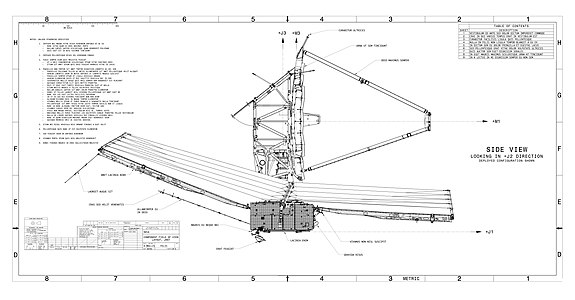ผู้ใช้:Thitut/ทดลองเขียน/กล้องโทรทรรศน์อวกาศเจมส์ เวบบ์
| กล้องโทรทรรศน์อวกาศเจมส์ เวบบ์ | |
|---|---|
 ภาพเรนเดอร์กล้องโทรทัศน์อวกาศเจมส์ เว็บบ์ที่ส่วนประกอบทั้งหมดกางออก | |
| รายชื่อเก่า | Next Generation Space Telescope (NGST; 1996–2002) |
| ประเภทภารกิจ | ดาราศาสตร์ |
| ผู้ดำเนินการ | NASA / ESA / CSA / STScI[1] |
| เว็บไซต์ | webbtelescope |
| ระยะภารกิจ | 10 ปี (วางแผน) |
| ข้อมูลยานอวกาศ | |
| ผู้ผลิต |
|
| มวลขณะส่งยาน | 6,161.4 kg (13,584 lb)[2] |
| ขนาด | 20.197 × 14.162 m (66.26 × 46.46 ft), ฉากกันแสงอาทิตย์ |
| กำลังไฟฟ้า | 2 kW |
| เริ่มต้นภารกิจ | |
| วันที่ส่งขึ้น | 25 ธันวาคม 2021, 12:20 UTC[3] |
| จรวดนำส่ง | อารีอาน 5 ECA (VA256) |
| ฐานส่ง | ศูนย์อวกาศเกียนา, ELA-3 |
| ผู้ดำเนินงาน | อารีอานสเปซ |
| ลักษณะวงโคจร | |
| ระบบอ้างอิง | จุดลากรองจ์ที่ 2 ระหว่างโลก-ดวงอาทิตย์ |
| ระบบวงโคจร | วงโคจรฮาโล |
| ระยะใกล้สุด | 374,000 km (232,000 mi)[4] |
| ระยะไกลสุด | 1,500,000 km (930,000 mi) |
| คาบการโคจร | 6 เดือน |
| กล้องโทรทรรศน์หลัก | |
| ชนิด | ระบบลดความบิดเบือนภาพสามกระจกแบบคอร์ช |
| เส้นผ่านศูนย์กลาง | 6.5 m (21 ft) |
| ระยะโฟกัส | 131.4 m (431 ft) |
| อัตราส่วนโฟกัส | f/20.2 |
| พื่นที่รับแสง | 25.4 m2 (273 sq ft)[5] |
| ความยาวคลื่น | 0.6–28.3 μm (ส้มถึงอินฟราเรดช่วงกลาง) |
| อุปกรณ์ส่งสัญญาณ | |
| ย่านความถี่ |
|
| แบนด์วิดท์ |
|
| เครื่องมือ | |
| FGS-NIRISS | เซ็นเซอร์นำทางความละเอียดสูงและตัวสร้างภาพคลื่นใกล้อินฟราเรดและสเปกโทรกราฟไร้แผ่นบัง |
| MIRI | เครื่องมือวัดอินฟราเรดกลาง |
| NIRCam | กล้องถ่ายคลื่นใกล้อินฟราเรด |
| NIRSpec | สเปกโตรกราฟคลื่นใกล้อินฟราเรด |
| องค์ประกอบ | |
| |
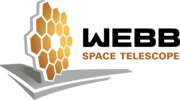 สัญลักษณ์ภารกิจกล้องโทรทรรศน์อวกาศเจมส์ เวบบ์ | |
กล้องโทรทรรศน์อวกาศเจมส์ เวบบ์ (อังกฤษ: James Webb Space Telescope; JWST) เป็นกล้องโทรทรรศน์อวกาศที่ถูกพัฒนาร่วมกันระหว่างองค์กรนาซา กับองค์การอวกาศยุโรป (ESA) และองค์การอวกาศแคนาดา (CSA) เพื่อสืบทอดภารกิจของกล้องโทรทรรศน์อวกาศฮับเบิลในการเป็นภารกิจฟิสิกส์ดาราศาสตร์หลักของนาซา[6][7] กล้องโทรทรรศน์อวกาศเจมส์ เวบบ์นั้นมีกำหนดปล่อยไม่เร็วไปกว่าวันที่ 25 ธันวาคม 2021 มันจะสามารถมอบภาพในคลื่นอินฟราเรดได้ด้วยความคมชัดและความไวต่อแสงได้มากกว่ากล้องโทรทรรศน์อวกาศฮับเบิล และเปิดโอกาสในการศึกษาในสาขาของดาราศาสตร์ และจักรวาลวิทยา นั้นรวมถึงการสังเกตการณ์วัตถุและเหตุการณ์ที่ห่างไกลที่สุดในเอกภพ เช่นการกำเนิดและวิวัฒนาการของดาราจักร และลักษณะเฉพาะอย่างละเอียดของชั้นบรรยากาศของดาวเคราะห์นอกระบบที่อาจเอื้อชีวิต
องค์ประกอบกล้องโทรทรรศน์แสง เป็นกระจกสะท้อนหลักของกล้องโทรทรรศน์อวกาศเจมส์ เวบบ์ ซึ่งประกอบไปด้วยกระจกเบริลเลียมเคลือบทองทรงหกเหลี่ยม 18 ส่วน ซึ่งประกอบกันเพื่อสร้างกระจกเส้นผ่านศูนย์กลาง 6.5 m (21 ft) — ใหญ่กว่ากระจกสะท้อนหลักของกล้องโทรทรรศน์อวกาศฮับเบิลขนาด 2.4 m (7 ft 10 in) เป็นอย่างมาก กล้องโทรทรรศน์อวกาศเจมส์ เวบบ์จะสังเกตการณ์ในช่วงคลื่นแสงที่มองเห็นได้ไปจนถึงคลื่นอินฟราเรดกลาง (0.6 to 28.3 μm) ซึ่งต่างจากฮับเบิลซึ่งสังเกตการณ์ตั้งแต่คลื่นใกล้อัลตราไวโอเลต คลื่นแสงที่มองเห็นได้ และคลื่นใกล้อินฟราเรด (0.1 to 1 μm) การที่เจมส์ เวบบ์สังเกตการณ์ในคลื่นที่ต่ำกว่าจะทำให้มันสามารถเห็นวัตถุที่เลื่อนไปทางแดงอย่างมากซึ่งมีเก่าและไกลเกินกว่าที่ฮับเบิลจะมองเห็นได้[8][9] ตัวกล้องโทรทรรศน์จะต้องถูกรักษาไว้ในสภาพเย็นจัดเพื่อที่จะสามารถสังเกตการณ์เคลื่อนอินฟราเรดได้ด้วยไม่มีการรบกวน มันจึงจะถึงปล่อยไปยังบริเวณจุดลากรองจ์ที่ 2 ระหว่างโลก-ดวงอาทิตย์ ประมาณ 1.5 ล้าน กิโลเมตร (930,000 ไมล์) จากโลก (0.01 au – 3.9 เท่าระยะทางจากโลกสู่ดวงจันทร์).[10]ฉากกันแสงอาทิตย์ขนาดใหญ่ผลิตด้วยซิลิคอน และแคปตอนเคลือบอลูมิเนียมจะช่วยรักษาอุณหภูมิของกระจกรับแสงและเครื่องมือวัดให้ต่ำกว่า 50 K (−223 °C; −370 °F).[11]
ศูนย์การบินอวกาศก็อดดาร์ดของนาซาเป็นผู้จัดการการพัฒนากล้องโทรทรรศน์อวกาศ และสถาบันวิทยาศาสตร์กล้องโทรทรรศน์อวกาศจะเป็นผู้ดำเนินการหลังจากการปล่อย[12] ผู้รับเหมาหลักคือนอร์ทธรอป กรัมแมน[13] ตัวกล้องโทรทรรศน์ถูกตั้งชื่อตามเจมส์ อี. เวบบ์[14] ซึ่งเป็นผู้บริหารองค์การนาซาตั้งแต่ปี 1961 ถึง 1968 และเป็นบุคคลสำคัญในโครงการอะพอลโล[15][16]
การพัฒนาเริ่มต้นขึ้นในปี 1996 สำหรับการปล่อยที่แรกเริ่มวางแผนไว้ในปี 2007 และใช้งบประมาณ 500 ล้านดอลลาร์สหรัฐ[17] โครงการนี้เกิดการล้าช้าและค่าใช้จ่ายสูงกว่างบประมาณอยู่หลายครั้ง เช่น การออกแบบใหม่ในปี 2005[18] ฉากกันแสงอาทิตย์ขาดระหว่างการทดสอบการกาง คำแนะนำจากคณะกรรมการตรวจสอบอิสระ การระบาดทั่วของโควิด-19[19][20][21] ปัญหากับจรวดอารีอาน 5[22] ปัญหากับตัวกล้องโทรทรรศน์เอง และปัญหาการสื่อสารระหว่างกล้องโทรทัศน์และจรวด[23] ความกังวลในกลุ่มนักวิทยาศาสตร์และวิศวกรที่เกี่ยวข้องเกี่ยวกับการปล่อยและการกางตัวของกล้องโทรทรรศน์ได้ถูกอธิบายเป็นอย่างดี[24][25]
การก่อสร้างเสร็จสิ้นช่วงปลายปี 2016 หลังจากนั้นจึงเริ่มช่วงการทดสอบอย่างครอบคลุม[26][27] ในวันที่ 21 ธันวาคม 2021 นาซาประกาศว่าเจมส์ เว็บบ์มีกำหนดปล่อย ณ เวลา 12:20 UTC ในวันที่ 25 ธันวาคม 2021 ด้วยจรวดอารีอาน 5 จาก กูรู, เฟรนช์เกียนา บริเวณหาดทางตะวันออกเฉียงเหนือของทวีปอเมริกาใต้[3][28][29]
ความสามารถ[แก้]
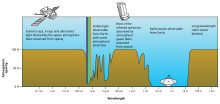
กล้องโทรทรรศน์อวกาศเจมส์ เวบบ์คาดว่าจะมีมวลเพียงครึ่งหนึ่งของกล้องโทรทรรศน์อวกาศฮับเบิล แต่กระจกสะท้อนหลักของมันซึ่งประกอบไปด้วยกระจกเบริลเลียมเคลือบทองทรงหกเหลี่ยม 18 ชิ้น จะมีเส้นผ่านศูนย์กลางรวม 6.5 m (21 ft) และมีพื้นที่รับแสง 25.4 m2 (273 sq ft) เมื่อหักพื้นที่ที่ถูกบดบังไปโดยเสาค้ำรอง 0.9 m2 (9.7 sq ft) เจมส์ เวบบ์จะมีพื้นที่รับแสงมากกว่าฮับเบิลถึงหกเท่า[30]
กล้องโทรทรรศน์อวกาศเจมส์ เวบบ์นั้นถูกออกแบบมาด้วยมีวัตถุประสงค์หลักในการใช้ศึกษาดาราศาสตร์คลื่นใกล้อินฟราเรด แต่ก็ยังสามารถมองเห็นแสงสีส้มและแดง รวมถึงคลื่นอินฟราเรดช่วงกลาง ขึ้นอยู่กับเครื่องมือที่ใช้ศึกษา การที่การออกแบบเน้นสำหรับการใช้ในคลื่นใกล้อินฟราเรดถึงอินฟราเรดช่วงกลาเป็นงด้วยสามเหตุผลคือ
- แสงที่มองเห็นได้ที่เปล่งออกมาจากวัตถุที่เลื่อนไปทางแดงมาก จะเลื่อนไปอยู่ในช่วงคลื่นอินฟราเรด
- วัตถุที่เย็นเช่นจานเศษฝุ่นและดาวเคราะห์เปล่งแสงมากที่สุดในคลื่นอินฟราเรด
- การศึกษาคลื่นนี้จากบนพื้นโลกหรือโดยการใช้กล้องโทรทรรศน์ที่มีอยู่ปัจจุบันเช่น ฮับเบิล นั้นเป็นไปได้ยาก
กล้องโทรทรรศน์ภาคพื้นดินจะต้องสังเกตการณ์ผ่านชั้นบรรยากาศของโลก ถึงบดบังคลื่นอินฟราเรดหลายช่วง และแม้ในช่วงคลื่นที่ชั้นบรรยากาศไม่บดบัง สารเคมีเป้าหมายหลายชนิดเช่น น้ำ คาร์บอนไดออกไซด์ และมีเทน ก็มีอยู่แล้วในบรรยากาศของโลก ทำให้การวิเคราะห์ผลลับซับซ้อนขึ้นไปมาก กล้องโทรทรรศน์อวกาศที่มีอยู่ในปัจจุบันเช่น ฮับเบิล ก็ไม่สามารถศึกษาคลื่นช่วงนี้ได้ เนื่องจากกระจกของมันถูกรักษาไว้ในอุณหภูมิที่ต่ำไม่พอ (กระจกสะท้อนหลักของฮับเบิลถูกรักษาไว้ที่อุณหภูมิประมาณ 15 °C (288 K; 59 °F)) ตัวกล้องโทรทรรศน์เองจึงเปล่งคลื่นอินฟราเรดอย่างรุนแรง[31]
กล้องโทรทรรศน์อวกาศเจมส์ เวบบ์จะทำงานใกล้จุดลากรองจ์ที่ 2 ระหว่างโลก-ดวงอาทิตย์ ประมาณ 1,500,000 km (930,000 mi) ห่างจากวงโคจรของโลก เปรียบเทียบกับวงโคจรของฮับเบิลซึ่งอยู่ 550 km (340 mi) เหนือพื้นโลก และดวงจันทร์โคจรอยู่ห่างจากโลกประมาณ 400,000 km (250,000 mi) จากโลก ด้วยระยะทางที่ห่างไกลเท่านี้จะทำให้การซ่อมหลังการปล่อยหรือต่อเติมยกระดับส่วนเครื่องของเจมส์ เวบบ์ แทบจะเป็นไปไม่ได้ ตัวยานอวกาศจึงจะสามารถเข้าถึงได้เฉพาะในช่วงการสร้างและออกแบบเท่านั้น วัตถุที่อยู่ใกล้จุดลากรองจ์นี้สามารถโคจรดวงอาทิตย์ไปพร้อมกับโลก ทำให้ตัวกล้องโทรทรรศน์มีระยะห่างคงที่โดยประมาณ[32] เจมส์ เวบบ์จะหันฉากกันแสงอาทิตย์และบัสเข้าสู่โลกและดวงอาทิตย์เพื่อสะท้อนแสงและความร้อนที่แผ่จากโลกและดวงอาทิตย์ และรักษาการสื่อสาร การเรียงตัวแนวนี้จะรักษาอุณหภูมิของยานอวกาศในอยู่ต่ำกว่า 50 K (−223 °C; −370 °F) ซึ่งจำเป็นจำหรับการสังเกตการณ์คลื่นอินฟราเรด[11][33]
-
ภาพจากมุมบน
-
ภาพจากมุมล่าง (ด้านหันหาดวงอาทิตย์)
-
พิมพ์เขียวของกล้องโทรทรรศน์อวกาศเจมส์ เวบบ์
ฉากกันแสงอาทิตย์[แก้]
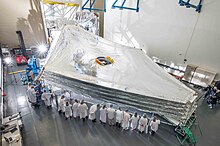
To make observations in the infrared spectrum, JWST must be kept under 50 K (−223.2 °C; −369.7 °F); otherwise, infrared radiation from the telescope itself would overwhelm its instruments. It therefore uses a large sunshield to block light and heat from the Sun, Earth, and Moon, and its position near the Earth–Sun L2 point keeps all three bodies on the same side of the spacecraft at all times.[34] Its halo orbit around the L2 point avoids the shadow of the Earth and Moon, maintaining a constant environment for the sunshield and solar arrays.[32] The shielding maintains a stable temperature for the structures on the dark side, which is critical to maintaining precise alignment of the primary mirror segments.space.[11]
The five-layer sunshield, each layer as thin as a human hair,[35] is constructed from Kapton E, a commercially available polyimide film from DuPont, with membranes specially coated with aluminum on both sides and a layer of silicon doped aluminum on the Sun-facing side of the two hottest layers to reflect the Sun's heat back into space.[11] Accidental tears of the delicate film structure during testing in 2018 were among the factors delaying the project.[36]
The sunshield is designed to be folded twelve times so that it will fit within the Ariane 5 rocket's payload fairing, which is 4.57 m (15.0 ft) in diameter, and 16.19 m (53.1 ft) long. Once deployed at the L2 point, it will unfold to 14.162 × 21.197 m (46.46 × 69.54 ft). The sunshield was hand-assembled at ManTech (NeXolve) in Huntsville, Alabama, before it was delivered to Northrop Grumman in Redondo Beach, California, for testing.[37]
Optics[แก้]
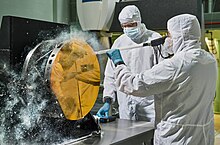
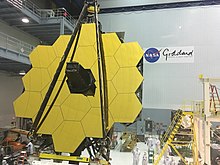
JWST's primary mirror is a 6.5 m (21 ft)-diameter gold-coated beryllium reflector with a collecting area of 25.4 m2 (273 sq ft). If it were built as a single large mirror, this would have been too large for existing launch vehicles. The mirror is therefore composed of 18 hexagonal segments which will unfold after the telescope is launched. Image plane wavefront sensing through phase retrieval will be used to position the mirror segments in the correct location using very precise micro-motors. Subsequent to this initial configuration, they will only need occasional updates every few days to retain optimal focus.[38] This is unlike terrestrial telescopes, for example the Keck telescopes, which continually adjust their mirror segments using active optics to overcome the effects of gravitational and wind loading. The Webb telescope will use 126 small motors to occasionally adjust the optics as there are few environmental disturbances of a telescope in space.[39]
JWST's optical design is a three-mirror anastigmat,[40] which makes use of curved secondary and tertiary mirrors to deliver images that are free from optical aberrations over a wide field. In addition, there is a fine steering mirror which can adjust its position many times per second to provide image stabilization.
Ball Aerospace & Technologies is the principal optical subcontractor for the JWST project, led by prime contractor Northrop Grumman Aerospace Systems, under a contract from the NASA Goddard Space Flight Center, in Greenbelt, Maryland.[41][42] Eighteen primary mirror segments, secondary, tertiary and fine steering mirrors, plus flight spares have been fabricated and polished by Ball Aerospace & Technologies based on beryllium segment blanks manufactured by several companies including Axsys, Brush Wellman, and Tinsley Laboratories.[ต้องการอ้างอิง]
The final segment of the primary mirror was installed on 3 February 2016,[43] and the secondary mirror was installed on 3 March 2016.[44]
Scientific instruments[แก้]


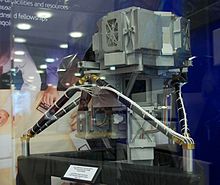
The Integrated Science Instrument Module (ISIM) is a framework that provides electrical power, computing resources, cooling capability as well as structural stability to the Webb telescope. It is made with bonded graphite-epoxy composite attached to the underside of Webb's telescope structure. The ISIM holds the four science instruments and a guide camera.[45]
- NIRCam (Near InfraRed Camera) is an infrared imager which will have a spectral coverage ranging from the edge of the visible (0.6 micrometers) through the near infrared (5 micrometers).[46][47] There are 10 sensors each of 4 megapixels. NIRCam will also serve as the observatory's wavefront sensor, which is required for wavefront sensing and control activities. NIRCam was built by a team led by the University of Arizona, with principal investigator Marcia J. Rieke. The industrial partner is Lockheed-Martin's Advanced Technology Center located in Palo Alto, California.[48]
- NIRSpec (Near InfraRed Spectrograph) will also perform spectroscopy over the same wavelength range. It was built by the European Space Agency at ESTEC in Noordwijk, Netherlands. The leading development team includes members from Airbus Defence and Space, Ottobrunn and Friedrichshafen, Germany, and the Goddard Space Flight Center; with Pierre Ferruit (École normale supérieure de Lyon) as NIRSpec project scientist. The NIRSpec design provides three observing modes: a low-resolution mode using a prism, an R~1000 multi-object mode, and an R~2700 integral field unit or long-slit spectroscopy mode.[49] Switching of the modes is done by operating a wavelength preselection mechanism called the Filter Wheel Assembly, and selecting a corresponding dispersive element (prism or grating) using the Grating Wheel Assembly mechanism.[49] Both mechanisms are based on the successful ISOPHOT wheel mechanisms of the Infrared Space Observatory. The multi-object mode relies on a complex micro-shutter mechanism to allow for simultaneous observations of hundreds of individual objects anywhere in NIRSpec's field of view. There are two sensors each of 4 megapixels. The mechanisms and their optical elements were designed, integrated and tested by Carl Zeiss Optronics GmbH of Oberkochen, Germany, under contract from Astrium.[49]
- MIRI (Mid-InfraRed Instrument) will measure the mid-to-long-infrared wavelength range from 5 to 27 micrometers.[50][51] It contains both a mid-infrared camera and an imaging spectrometer.[41] MIRI was developed as a collaboration between NASA and a consortium of European countries, and is led by George Rieke (University of Arizona) and Gillian Wright (UK Astronomy Technology Centre, Edinburgh, Scotland, part of the Science and Technology Facilities Council (STFC)).[48] MIRI features similar wheel mechanisms to NIRSpec which are also developed and built by Carl Zeiss Optronics GmbH under contract from the Max Planck Institute for Astronomy, Heidelberg, Germany. The completed Optical Bench Assembly of MIRI was delivered to Goddard Space Flight Center in mid-2012 for eventual integration into the ISIM. The temperature of the MIRI must not exceed 6 kelvins (K): a helium gas mechanical cooler sited on the warm side of the environmental shield provides this cooling.[52]
- FGS/NIRISS (Fine Guidance Sensor and Near Infrared Imager and Slitless Spectrograph), led by the Canadian Space Agency under project scientist John Hutchings (Herzberg Astronomy and Astrophysics Research Centre, National Research Council), is used to stabilize the line-of-sight of the observatory during science observations. Measurements by the FGS are used both to control the overall orientation of the spacecraft and to drive the fine steering mirror for image stabilization. The Canadian Space Agency is also providing a Near Infrared Imager and Slitless Spectrograph (NIRISS) module for astronomical imaging and spectroscopy in the 0.8 to 5 micrometre wavelength range, led by principal investigator René Doyon at the Université de Montréal.[48] Because the NIRISS is physically mounted together with the FGS, they are often referred to as a single unit; however, they serve entirely different purposes, with one being a scientific instrument and the other being a part of the observatory's support infrastructure.
NIRCam and MIRI feature starlight-blocking coronagraphs for observation of faint targets such as extrasolar planets and circumstellar disks very close to bright stars.[51]
The infrared detectors for the NIRCam, NIRSpec, FGS, and NIRISS modules are being provided by Teledyne Imaging Sensors (formerly Rockwell Scientific Company). The James Webb Space Telescope (JWST) Integrated Science Instrument Module (ISIM) and Command and Data Handling (ICDH) engineering team uses SpaceWire to send data between the science instruments and the data-handling equipment.[53]
Spacecraft Bus[แก้]

The Spacecraft Bus is the primary support component of the James Webb Space Telescope, that hosts a multitude of computing, communication, electric power, propulsion, and structural parts, bringing the different parts of the telescope together.[54] Along with the sunshield, it forms the spacecraft element of the space telescope.[55] The other two major elements of JWST are the Integrated Science Instrument Module (ISIM) and the Optical Telescope Element (OTE).[56] Region 3 of ISIM is also inside the Spacecraft Bus; region 3 includes ISIM Command and Data Handling subsystem and the MIRI cryocooler.[56] The Spacecraft Bus is connected to Optical Telescope Element via the Deployable Tower Assembly, which also connects to the sunshield.[54] The Spacecraft Bus is on the Sun-facing "warm" side of the sunshield and operates at a temperature of about 300 K (27 °C; 80 °F).[55]
The structure of the Spacecraft Bus weighs 350 kg (770 lb), and must support the 6,200 kg (13,700 lb) space telescope.[57] It is made primarily of graphite composite material.[57] It was assembled in California, assembly was completed in 2015, and then it had to be integrated with the rest of the space telescope leading up to its planned 2021 launch. The spacecraft bus can rotate the telescope with a pointing precision of one arcsecond, and isolates vibration down to two milliarcseconds.[58]
In the central computing, memory storage, and communications equipment,[54] the processor and software direct data to and from the instruments, to the solid-state memory core, and to the radio system which can send data back to Earth and receive commands.[54] The computer also controls the pointing of the spacecraft, taking in sensor data from the gyroscopes and star tracker, and sending commands to the reaction wheels or thrusters.[54]
The spacecraft has 10 pairs of thrusters, each pair consisting of one primary and a redundant back up. The thrusters use hydrazine fuel (159 liters at launch) and dinitrogen tetroxide as oxidizer (79.5 liters at launch).[59]
ดูเพิ่ม[แก้]
อ้างอิง[แก้]
- ↑ "NASA JWST "Who are the partners in the Webb project?"". NASA. สืบค้นเมื่อ 18 November 2011.
 บทความนี้รวมเอาเนื้อความจากแหล่งอ้างอิงนี้ ซึ่งเป็นสาธารณสมบัติ
บทความนี้รวมเอาเนื้อความจากแหล่งอ้างอิงนี้ ซึ่งเป็นสาธารณสมบัติ
- ↑ Clark, Stephen [@StephenClark1] (23 December 2021). "The exact launch mass of the James Webb Space Telescope: 6161.4 kilograms. That figure includes 167.5 kg of hydrazine and 132.5 kg of dinitrogen tetroxide for the propulsion system" (ทวีต). สืบค้นเมื่อ 23 December 2021 – โดยทาง ทวิตเตอร์.
- ↑ 3.0 3.1 "James Webb Space Telescope Launch Update". NASA. 21 December 2021. สืบค้นเมื่อ 21 December 2021.
 บทความนี้รวมเอาเนื้อความจากแหล่งอ้างอิงนี้ ซึ่งเป็นสาธารณสมบัติ
บทความนี้รวมเอาเนื้อความจากแหล่งอ้างอิงนี้ ซึ่งเป็นสาธารณสมบัติ
- ↑ "James Webb Space Telescope". ESA eoPortal. สืบค้นเมื่อ 29 June 2015.
- ↑ "JWST Telescope". James Webb Space Telescope User Documentation. Space Telescope Science Institute. 2019-12-23. สืบค้นเมื่อ 2020-06-11.
 บทความนี้รวมเอาเนื้อความจากแหล่งอ้างอิงนี้ ซึ่งเป็นสาธารณสมบัติ
บทความนี้รวมเอาเนื้อความจากแหล่งอ้างอิงนี้ ซึ่งเป็นสาธารณสมบัติ
- ↑ "About the James Webb Space Telescope". สืบค้นเมื่อ 13 January 2012.
 บทความนี้รวมเอาเนื้อความจากแหล่งอ้างอิงนี้ ซึ่งเป็นสาธารณสมบัติ
บทความนี้รวมเอาเนื้อความจากแหล่งอ้างอิงนี้ ซึ่งเป็นสาธารณสมบัติ
- ↑ "How does the Webb Contrast with Hubble?". NASA. คลังข้อมูลเก่าเก็บจากแหล่งเดิมเมื่อ 3 December 2016. สืบค้นเมื่อ 4 December 2016.
 บทความนี้รวมเอาเนื้อความจากแหล่งอ้างอิงนี้ ซึ่งเป็นสาธารณสมบัติ
บทความนี้รวมเอาเนื้อความจากแหล่งอ้างอิงนี้ ซึ่งเป็นสาธารณสมบัติ
- ↑ "James Webb Space Telescope JWST History: 1989-1994". Space Telescope Science Institute, Baltimore, Maryland. 2017. คลังข้อมูลเก่าเก็บจากแหล่งเดิมเมื่อ 3 February 2014. สืบค้นเมื่อ 29 December 2018.
- ↑ "Instrumentation of JWST". Space Telescope Science Institute. 29 January 2020. สืบค้นเมื่อ 29 January 2020.
- ↑ "L2, the second Lagrangian Point". สืบค้นเมื่อ 5 December 2021.
- ↑ 11.0 11.1 11.2 11.3 "The Sunshield". nasa.gov. NASA. สืบค้นเมื่อ 28 August 2016.
 บทความนี้รวมเอาเนื้อความจากแหล่งอ้างอิงนี้ ซึ่งเป็นสาธารณสมบัติ
บทความนี้รวมเอาเนื้อความจากแหล่งอ้างอิงนี้ ซึ่งเป็นสาธารณสมบัติ
- ↑ "About Webb". NASA. 2019. สืบค้นเมื่อ 4 June 2021.
 บทความนี้รวมเอาเนื้อความจากแหล่งอ้างอิงนี้ ซึ่งเป็นสาธารณสมบัติ
บทความนี้รวมเอาเนื้อความจากแหล่งอ้างอิงนี้ ซึ่งเป็นสาธารณสมบัติ
- ↑ "James Webb Space Telescope". Northrop Grumman. 2017. สืบค้นเมื่อ 31 January 2017.
- ↑ Witze, Alexndra (23 July 2021). "NASA investigates renaming James Webb telescope after anti-LGBT+ claims—Some astronomers argue the flagship observatory—successor to the Hubble Space Telescope—will memorialize discrimination. Others are waiting for more evidence". Nature. 596 (7870): 15–16. doi:10.1038/d41586-021-02010-x. PMID 34302150. S2CID 236212498. สืบค้นเมื่อ 23 July 2021.
- ↑ "ESA JWST Timeline". คลังข้อมูลเก่าเก็บจากแหล่งเดิมเมื่อ 21 August 2003. สืบค้นเมื่อ 13 January 2012.
 บทความนี้รวมเอาเนื้อความจากแหล่งอ้างอิงนี้ ซึ่งเป็นสาธารณสมบัติ
บทความนี้รวมเอาเนื้อความจากแหล่งอ้างอิงนี้ ซึ่งเป็นสาธารณสมบัติ
- ↑ During, John. "The James Webb Space Telescope". NASA. สืบค้นเมื่อ 31 December 2011.
 บทความนี้รวมเอาเนื้อความจากแหล่งอ้างอิงนี้ ซึ่งเป็นสาธารณสมบัติ
บทความนี้รวมเอาเนื้อความจากแหล่งอ้างอิงนี้ ซึ่งเป็นสาธารณสมบัติ
- ↑ อ้างอิงผิดพลาด: ป้ายระบุ
<ref>ไม่ถูกต้อง ไม่มีการกำหนดข้อความสำหรับอ้างอิงชื่อstsci1996 - ↑ อ้างอิงผิดพลาด: ป้ายระบุ
<ref>ไม่ถูกต้อง ไม่มีการกำหนดข้อความสำหรับอ้างอิงชื่อreplan - ↑ Foust, Jeff (March 20, 2020). "Coronavirus pauses work on JWST". SpaceNews.
- ↑ "James Webb Space Telescope to launch in October 2021". www.esa.int. แม่แบบ:PD notice
- ↑ Overbye, Dennis (16 July 2020). "NASA Delays James Webb Telescope Launch Date, Again – The universe will have to wait a little longer". The New York Times. สืบค้นเมื่อ 17 July 2020.
- ↑ Foust, Jeff (12 May 2021). "Ariane 5 issue could delay JWST". SpaceNews. สืบค้นเมื่อ 13 May 2021.
- ↑ "Update on Webb telescope launch". NASA. 14 December 2021. สืบค้นเมื่อ 14 December 2021.
 บทความนี้รวมเอาเนื้อความจากแหล่งอ้างอิงนี้ ซึ่งเป็นสาธารณสมบัติ
บทความนี้รวมเอาเนื้อความจากแหล่งอ้างอิงนี้ ซึ่งเป็นสาธารณสมบัติ
- ↑ Overbye, Dennis (14 December 2021). "Why the World's Astronomers Are Very, Very Anxious Right Now - The James Webb Space Telescope is endowed with the hopes and trepidations of a generation of astronomers". The New York Times. สืบค้นเมื่อ 15 December 2021.
- ↑ Karlis, Nicole (19 December 2021). "Decades of work are riding on the James Webb Space Telescope - What happens if it fails? - As one of the most expensive space missions in history, there's a lot on the line for launch". salon.com. สืบค้นเมื่อ 19 December 2021.
- ↑ "James Webb Space Telescope observatory is assembled". Space Daily. 29 December 2016. สืบค้นเมื่อ 3 February 2017.
- ↑ Foust, Jeff (23 December 2016). "No damage to JWST after vibration test anomaly". SpaceNews. สืบค้นเมื่อ 3 February 2017.
- ↑ Overbye, Dennis (20 December 2021). "Webb Telescope Prepares to Ascend, With an Eye Toward Our Origins - The biggest space telescope in history aims to answer astronomy's oldest question: How did we get from the Big Bang to here?". The New York Times. สืบค้นเมื่อ 20 December 2021.
- ↑ Roulette, Joey (23 December 2021). "How NASA's Biggest Telescope Beat Loose Screws, Loose Budgets and Loose Clamps - Getting the James Webb Space Telescope to the launchpad has been a difficult journey that has taken decades". The New York Times. สืบค้นเมื่อ 23 December 2021.
- ↑ Lallo, Matthew D. (2012). "Experience with the Hubble Space Telescope: 20 years of an archetype". Optical Engineering. 51 (1): 011011–011011–19. arXiv:1203.0002. Bibcode:2012OptEn..51a1011L. doi:10.1117/1.OE.51.1.011011. S2CID 15722152.
- ↑ อ้างอิงผิดพลาด: ป้ายระบุ
<ref>ไม่ถูกต้อง ไม่มีการกำหนดข้อความสำหรับอ้างอิงชื่อipac.caltech.edu - ↑ 32.0 32.1 "L2 Orbit". Space Telescope Science Institute. คลังข้อมูลเก่าเก็บจากแหล่งเดิมเมื่อ 3 February 2014. สืบค้นเมื่อ 28 August 2016.
- ↑ Drake, Nadia (24 April 2015). "Hubble Still Wows At 25, But Wait Till You See What's Next". National Geographic.
- ↑ "The James Webb Space Telescope". nasa.gov. สืบค้นเมื่อ 28 August 2016.
 บทความนี้รวมเอาเนื้อความจากแหล่งอ้างอิงนี้ ซึ่งเป็นสาธารณสมบัติ
บทความนี้รวมเอาเนื้อความจากแหล่งอ้างอิงนี้ ซึ่งเป็นสาธารณสมบัติ
- ↑ "Sunshield Coatings Webb/NASA". jwst.nasa.gov. สืบค้นเมื่อ 2020-05-03.
 บทความนี้รวมเอาเนื้อความจากแหล่งอ้างอิงนี้ ซึ่งเป็นสาธารณสมบัติ
บทความนี้รวมเอาเนื้อความจากแหล่งอ้างอิงนี้ ซึ่งเป็นสาธารณสมบัติ
- ↑ "NASA announces more delays for giant space telescope". sciencemag.org. 27 March 2018. สืบค้นเมื่อ 5 June 2018.
- ↑ Morring, Jr., Frank, Sunshield Aviation Week and Space Technology 16 December 2013, pp. 48-49
- ↑ "JWST Wavefront Sensing and Control". Space Telescope Science Institute. คลังข้อมูลเก่าเก็บจากแหล่งเดิมเมื่อ 5 August 2012. สืบค้นเมื่อ 9 June 2011.
- ↑ Mallonee, Laura. "NASA's Biggest Telescope Ever Prepares for a 2021 Launch". 9. สืบค้นเมื่อ 4 June 2021.
- ↑ "JWST Mirrors". Space Telescope Science Institute. คลังข้อมูลเก่าเก็บจากแหล่งเดิมเมื่อ 5 August 2012. สืบค้นเมื่อ 9 June 2011.
- ↑ 41.0 41.1 "JWST". NASA. สืบค้นเมื่อ 29 June 2015.
 บทความนี้รวมเอาเนื้อความจากแหล่งอ้างอิงนี้ ซึ่งเป็นสาธารณสมบัติ
บทความนี้รวมเอาเนื้อความจากแหล่งอ้างอิงนี้ ซึ่งเป็นสาธารณสมบัติ
- ↑ "Science Instruments of NASA's James Webb Space Telescope Successfully Installed". NASA. 24 May 2016. สืบค้นเมื่อ 2 February 2017.
 บทความนี้รวมเอาเนื้อความจากแหล่งอ้างอิงนี้ ซึ่งเป็นสาธารณสมบัติ
บทความนี้รวมเอาเนื้อความจากแหล่งอ้างอิงนี้ ซึ่งเป็นสาธารณสมบัติ
- ↑ "NASA's James Webb Space Telescope Primary Mirror Fully Assembled". NASA. 4 February 2016. สืบค้นเมื่อ 23 March 2016.
 บทความนี้รวมเอาเนื้อความจากแหล่งอ้างอิงนี้ ซึ่งเป็นสาธารณสมบัติ
บทความนี้รวมเอาเนื้อความจากแหล่งอ้างอิงนี้ ซึ่งเป็นสาธารณสมบัติ
- ↑ "NASA's James Webb Space Telescope Secondary Mirror Installed". NASA. 7 March 2016. สืบค้นเมื่อ 23 March 2016.
 บทความนี้รวมเอาเนื้อความจากแหล่งอ้างอิงนี้ ซึ่งเป็นสาธารณสมบัติ
บทความนี้รวมเอาเนื้อความจากแหล่งอ้างอิงนี้ ซึ่งเป็นสาธารณสมบัติ
- ↑ อ้างอิงผิดพลาด: ป้ายระบุ
<ref>ไม่ถูกต้อง ไม่มีการกำหนดข้อความสำหรับอ้างอิงชื่อisim - ↑ "James Webb Space Telescope Near Infrared Camera". STScI. คลังข้อมูลเก่าเก็บจากแหล่งเดิมเมื่อ 21 March 2013. สืบค้นเมื่อ 24 October 2013.
- ↑ "NIRCam for the James Webb Space Telescope". University of Arizona. สืบค้นเมื่อ 24 October 2013.
- ↑ 48.0 48.1 48.2 "JWST Current Status". STScI. คลังข้อมูลเก่าเก็บจากแหล่งเดิมเมื่อ 15 July 2009. สืบค้นเมื่อ 5 July 2008.
- ↑ 49.0 49.1 49.2 "NIRSpec – the near-infrared spectrograph on JWST". European Space Agency. 22 February 2015. สืบค้นเมื่อ 2 February 2017.
- ↑ อ้างอิงผิดพลาด: ป้ายระบุ
<ref>ไม่ถูกต้อง ไม่มีการกำหนดข้อความสำหรับอ้างอิงชื่อmiri - ↑ 51.0 51.1 "JWST: Mid-Infrared Instrument (MIRI)". NASA. 2017. สืบค้นเมื่อ 3 February 2017.
 บทความนี้รวมเอาเนื้อความจากแหล่งอ้างอิงนี้ ซึ่งเป็นสาธารณสมบัติ
บทความนี้รวมเอาเนื้อความจากแหล่งอ้างอิงนี้ ซึ่งเป็นสาธารณสมบัติ
- ↑ Banks, Kimberly; Larson, Melora; Aymergen, Cagatay; Zhang, Burt (2008). Angeli, George Z.; Cullum, Martin J. (บ.ก.). "James Webb Space Telescope Mid-Infrared Instrument Cooler systems engineering" (PDF). Proceedings of SPIE. Modeling, Systems Engineering, and Project Management for Astronomy III. 7017: 5. Bibcode:2008SPIE.7017E..0AB. doi:10.1117/12.791925. S2CID 17507846. สืบค้นเมื่อ 6 February 2016.
Fig. 1. Cooler Architecture Overview
- ↑
"NASA's James Webb Space Telescope Gets 'Spacewired'" 2007
 บทความนี้รวมเอาเนื้อความจากแหล่งอ้างอิงนี้ ซึ่งเป็นสาธารณสมบัติ
บทความนี้รวมเอาเนื้อความจากแหล่งอ้างอิงนี้ ซึ่งเป็นสาธารณสมบัติ
- ↑ 54.0 54.1 54.2 54.3 54.4 "The Spacecraft Bus". NASA James Webb Space Telescope. 2017.
 บทความนี้รวมเอาเนื้อความจากแหล่งอ้างอิงนี้ ซึ่งเป็นสาธารณสมบัติ
บทความนี้รวมเอาเนื้อความจากแหล่งอ้างอิงนี้ ซึ่งเป็นสาธารณสมบัติ
- ↑ 55.0 55.1 "The JWST Observatory". NASA. 2017.
The Observatory is the space-based portion of the James Webb Space Telescope system and is comprisedof three elements: the Integrated Science Instrument Module (ISIM), the Optical Telescope Element (OTE), which includes the mirrors and backplane, and the Spacecraft Element, which includes the spacecraft bus and the sunshield
 บทความนี้รวมเอาเนื้อความจากแหล่งอ้างอิงนี้ ซึ่งเป็นสาธารณสมบัติ
บทความนี้รวมเอาเนื้อความจากแหล่งอ้างอิงนี้ ซึ่งเป็นสาธารณสมบัติ
- ↑ 56.0 56.1 "Integrated Science Instrument Module (ISIM)". NASA James Webb Space Telescope. 2017. คลังข้อมูลเก่าเก็บจากแหล่งเดิมเมื่อ 3 December 2016. สืบค้นเมื่อ 30 November 2016.
 บทความนี้รวมเอาเนื้อความจากแหล่งอ้างอิงนี้ ซึ่งเป็นสาธารณสมบัติ
บทความนี้รวมเอาเนื้อความจากแหล่งอ้างอิงนี้ ซึ่งเป็นสาธารณสมบัติ
- ↑ 57.0 57.1 "JWST vital facts: mission goals". NASA James Webb Space Telescope. 2017. สืบค้นเมื่อ 29 January 2017.
 บทความนี้รวมเอาเนื้อความจากแหล่งอ้างอิงนี้ ซึ่งเป็นสาธารณสมบัติ
บทความนี้รวมเอาเนื้อความจากแหล่งอ้างอิงนี้ ซึ่งเป็นสาธารณสมบัติ
- ↑ Sloan, Jeff (12 October 2015). "James Webb Space Telescope spacecraft inches towards full assembly". Composites World.
- ↑ Clark, Stephen (November 28, 2021). "NASA gives green light to fuel James Webb Space Telescope". Spaceflight Now.



